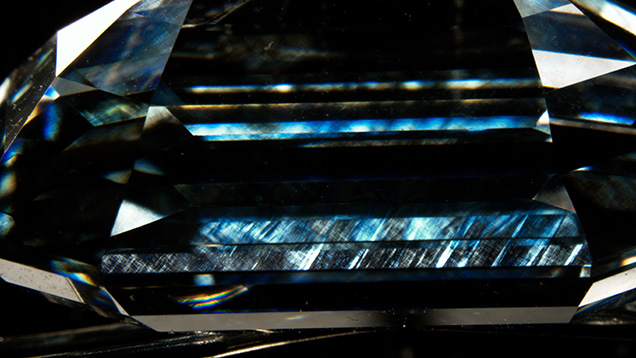The Type IIb De Beers Cullinan Blue Diamond

Type IIb blue diamonds are extremely rare in nature. When people think of blue diamonds, the Hope diamond immediately springs to mind. The famed 45.52 ct Fancy Deep grayish blue cushion-cut treasure, now housed in the Smithsonian National Museum of Natural History in Washington, DC, has a long and fascinating history. First examined by GIA in 1960 and graded by GIA in 1988 (R. Crowningshield, “Grading the Hope diamond,” Summer 1989 G&G, pp. 91–94), it shares many special gemological characteristics with other rare type IIb (boron-containing) diamonds such as the Wittelsbach-Graff, once assumed to be cut from the same rough crystal as the Hope. Here we report another special diamond of this group.
Recently graded by GIA and the recipient of a special monograph report was a 15.10 ct (17.47 × 11.53 × 7.94 mm) Fancy Vivid blue cut-cornered rectangular step cut. Named the De Beers Cullinan Blue diamond (figure 1; see video), it was cut from a 39.34 ct rough type IIb diamond crystal mined by Petra from the Cullinan (formerly Premier) mine in South Africa. Compared to the Hope and Wittelsbach-Graff, both of which were mined in the Golconda region of India, the De Beers Cullinan Blue has some important similarities in gemological and spectroscopic features but shows clear variations. Natural type IIb blue diamonds over 10 carats are exceedingly rare.
The blue color is distributed evenly throughout the stone. Visual observation under a gem microscope revealed a very clean stone. No inclusions or graining were observed. Accordingly, the diamond received a clarity grade of Internally Flawless. Under conventional long-wave and short-wave UV radiation, it showed no observable fluorescence or phosphorescence. This feature is dramatically different from that of the Hope and Wittelsbach-Graff, two large type IIb blue diamonds that exhibit strong and prolonged red phosphorescence to conventional short-wave UV radiation.

diamond.
The absorption spectrum in the mid-infrared region showed typical absorption features related to boron in diamond, such as strong absorption at ~2800 cm–1 and a weak absorption peak in the range of 1332–1200 cm–1 (figure 2). The intensities of these absorptions indicated a high concentration of uncompensated boron of ~0.33 ppm. Natural type IIb diamonds typically contain 0.24–0.36 ppm (E. Gaillou et al., “Study of the Blue Moon diamond,” Winter 2014 G&G, pp. 280–286). The diamond’s boron concentration is close to that of the Hope (~0.36 ppm) and higher than that of the Wittelsbach-Graff (~0.19 ppm). Absorption from boron is the main contributor of color in natural type IIb diamonds.

Observation with a gemological microscope equipped with crossed polarizers revealed a clear tatami pattern with a dark gray color (figure 3). Both the Wittelsbach-Graff and the Hope have different patterns and higher interference colors, a good indication that the De Beers Cullinan Blue has a much less distorted lattice structure. Under very strong short-wave UV, this diamond showed a weak aqua blue fluorescence with a subtle network of dislocations in the crystal structure, a pattern clearly different from the tight mosaic patterns observed in the Hope and the Wittelsbach-Graff (figure 4) (Gaillou et al., 2014).

These blue diamonds are among the rarest of gems. Recent research (E. Smith et al., “Blue boron-bearing diamonds from Earth’s lower mantle,” Nature, Vol. 560, No. 7716, 2018, pp. 84–87) has demonstrated that their boron derived from pieces of the earth’s crust sinking to the extremely deep depths of diamond formation. The gemological characteristics of the De Beers Cullinan Blue suggest it is one of these superdeep diamonds. Its combination of Fancy Vivid blue color grade in a step cut (a cut that does not enhance color, unlike other faceting styles) (see video), 15.10 ct weight, and Internally Flawless clarity grade is exceptionally rare. It will remain one of the world’s most important diamonds.



